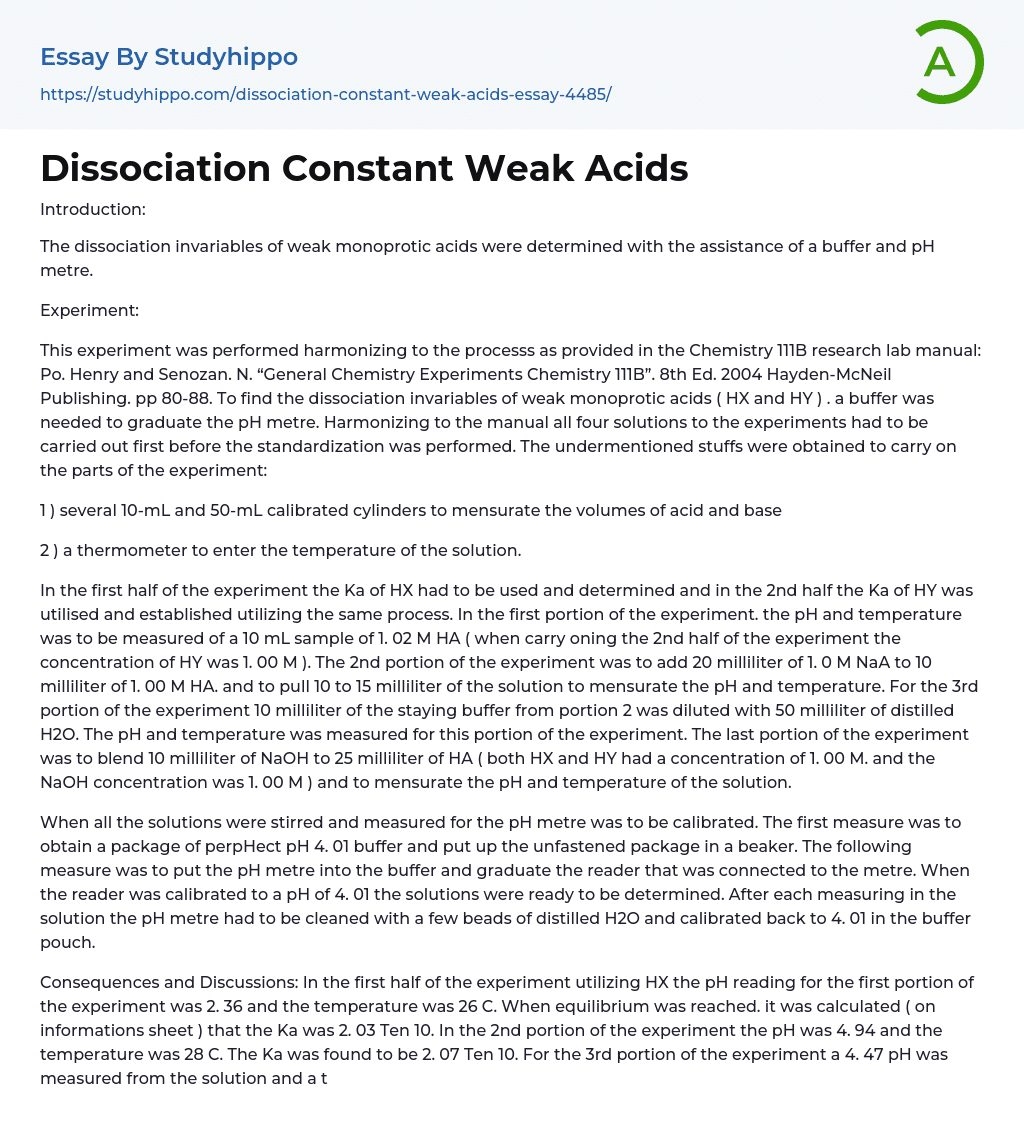Introduction:
The dissociation invariables of weak monoprotic acids were determined with the assistance of a buffer and pH metre.
Experiment:
This experiment was performed harmonizing to the processs as provided in the Chemistry 111B research lab manual: Po. Henry and Senozan. N. “General Chemistry Experiments Chemistry 111B”. 8th Ed. 2004 Hayden-McNeil Publishing. pp 80-88. To find the dissociation invariables of weak monoprotic acids ( HX and HY ) . a buffer was needed to graduate the pH metre. Harmonizing to the manual all four solutions to the experiments had to be carried out first before the standardization was performed. The undermentioned stuffs were obtained to carry on the parts of the experiment:
1 ) several 10-mL and 50-mL calibrated cylinders to men
...surate the volumes of acid and base
2 ) a thermometer to enter the temperature of the solution.
In the first half of the experiment the Ka of HX had to be used and determined and in the 2nd half the Ka of HY was utilised and established utilizing the same process. In the first portion of the experiment. the pH and temperature was to be measured of a 10 mL sample of 1. 02 M HA ( when carry oning the 2nd half of the experiment the concentration of HY was 1. 00 M ). The 2nd portion of the experiment was to add 20 milliliter of 1. 0 M NaA to 10 milliliter of 1. 00 M HA. and to pull 10 to 15 milliliter of the solution to mensurate the pH and temperature. For the 3rd portion of the experiment 10 milliliter of the staying buffer from portion 2 was diluted with 50 milliliter of distilled H2O
The pH and temperature was measured for this portion of the experiment. The last portion of the experiment was to blend 10 milliliter of NaOH to 25 milliliter of HA ( both HX and HY had a concentration of 1. 00 M. and the NaOH concentration was 1. 00 M ) and to mensurate the pH and temperature of the solution.
When all the solutions were stirred and measured for the pH metre was to be calibrated. The first measure was to obtain a package of perpHect pH 4. 01 buffer and put up the unfastened package in a beaker. The following measure was to put the pH metre into the buffer and graduate the reader that was connected to the metre. When the reader was calibrated to a pH of 4. 01 the solutions were ready to be determined. After each measuring in the solution the pH metre had to be cleaned with a few beads of distilled H2O and calibrated back to 4. 01 in the buffer pouch.
Consequences and Discussions: In the first half of the experiment utilizing HX the pH reading for the first portion of the experiment was 2. 36 and the temperature was 26 C. When equilibrium was reached. it was calculated ( on informations sheet ) that the Ka was 2. 03 Ten 10. In the 2nd portion of the experiment the pH was 4. 94 and the temperature was 28 C. The Ka was found to be 2. 07 Ten 10. For the 3rd portion of the experiment a 4. 47 pH was measured from the solution and a temperature of 27 C. The Ka for this portion was
2. 57 Ten 10. Last the pH of the solution for portion 4 was 4. 47 and had a temperature of 27 C with a Ka reading of 2. 29 Ten 10.
For the 2nd portion of the experiment covering with HY. readings of 1. 95. 25 C. and 1. 27 Ten 10 were measured for pH. temperature. and Ka. severally. In the 2nd portion of the experiment. the pH reading was 2. 94 with a temperature of 26 C and a Ka of 2. 31 Ten 10. In the 3rd portion of the experiment a pH measuring temperature and Ka values were found to be 2. 95. 26 C and 2. 32 Ten 10 severally. In the last portion of the experiment the pH reading was 2. 58 with a temperature of 27 C. The Ka for this peculiar solution was 1. 78 Ten 10.
Premises that were made from this experiment was that the Ka values for HX and HY were similar except for portion 1. Separate 1 was excluded in the norms in the informations sheet because since no base is present in the solution a different Ka value will be given so the other solutions which had base in the solution. Besides since the solutions of the experiment were prepared foremost before graduating the pH metre the group received a better pH reading because the pH of the solutions were measured one after the other.
Decision:
- In the experiment it was seen that the dissociation of weak monoprotic acids were changeless for HX and for HY given from the Ka values.
- Melting essays
- Acid essays
- Calcium essays
- Carbohydrate essays
- Carbon essays
- Chemical Bond essays
- Chemical Reaction essays
- Chemical reactions essays
- Chromatography essays
- Concentration essays
- Copper essays
- Diffusion essays
- Ethanol essays
- Hydrogen essays
- Organic Chemistry essays
- Osmosis essays
- Periodic Table essays
- Ph essays
- Salt essays
- Sodium essays
- Titration essays
- Atom essays
- Big Bang Theory essays
- Density essays
- Electricity essays
- Energy essays
- Force essays
- Heat essays
- Light essays
- Motion essays
- Nuclear Power essays
- Physiology essays
- Sound essays
- Speed essays
- Temperature essays
- Thermodynamics essays




